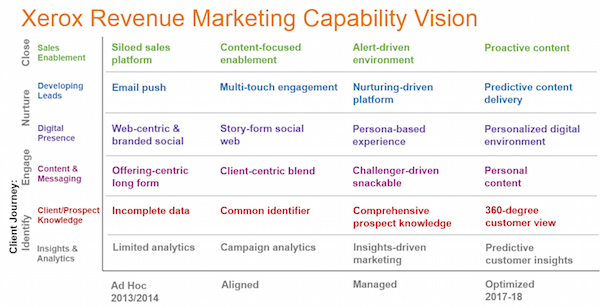If you were to take a poll of the hot topics in marketing these days, “social media” and “big data” would both be top contenders.
So when the folks at Viralheat, a provider of social media marketing software (covered in TechCrunch earlier this year), invited me to interview their Director of Business Intelligence, Erin Robbins O’Brien, on her perspective of “big data” and marketing, the hard part was narrowing my list of questions.
Tell us a bit about Viralheat and your role as Director of Business Intelligence.
Viralheat provides social media monitoring and analytics to businesses of all sizes, from individual contractors to agencies to enterprise clients. Viralheat was created with the belief that social media insights and management should be available to everyone, not just those with big budgets. From that we have developed proprietary technologies including a sentiment analysis tool that utilizes a combination of natural language processing and machine learning, as well as a (patent pending) Human Intent tool, which identifies social leads. One of the things I’m most excited about for marketers is our influencer identification capability.
My role at Viralheat has evolved as we have grown as an organization. I actually started out running the marketing department, which has encompassed public relations, customer success, community management and advertising — in addition to traditional marketing duties such as email and lead generation. My background is in digital strategy and human behavioral sciences, so as the company grows I am able to take on a role that allows me to utilize those skills as a more formalized job (meaning there aren’t only four of us here so I can stop wearing 15 hats!).
Some of the things I work on include the aggregation of all of our data, across marketing, user engagement, website, in-product, customer support, etc., into a single repository. By utilizing a distinct categorization system, I can compare campaigns, marketing channels, target audiences and much more across every facet of the company, so that we can make smarter product, marketing and positioning decisions moving forward.
How do you see the relationship between business intelligence and marketing? Is it changing?
It should be peanut butter jelly time between us. Honestly, there is so much value that each position can provide to the other, anything other than a symbiotic, reciprocal relationship is both ludicrous and useless. Business intelligence needs marketing to provide feedback about the customer experience and to set up campaigns and outreach in a way that can be measured and useful to the rest of the organization. Marketing needs business intelligence to aggregate data from across every corner of the company, industry, and competition to give them the best chance at generating leads, reducing churn, and upselling users. Pilot and navigator.
“Marketing needs business intelligence to aggregate data from across every corner of the company, industry, and competition.”
It’s not always like that though. The relationship will have to evolve. Right now, not every organization has a business intelligence department and sometimes, if they do, they’re not in direct communication with marketing. I’ve seen marketing professionals who are unsure what to do with the mountains of stats and analytics that BI teams can provide and BI teams that wonder why marketers aren’t measuring things differently. Those, along with other issues, are things we’ve got to sort out together, for the survival and betterment of both groups.
What’s the difference between “big data” and “small data” in marketing? Is it quantitative or qualitative?
People often get hung up on “big” as a reference to millions or billions of pieces of data. While the volume of data is a contributing factor, there are actually three components that typically determine data size. With regards to marketers, data can be quantitative or qualitative in nature, but should have some form of measurement or scoring regardless of type.
The three contributing factors to data’s “bigness” can be broken down as follows:
- Condition — Condition can also be referred to as “cleanliness.” As an example, a list of email addresses from existing customers that has been checked for unsubscribers, valid and current addresses, etc., is considered “clean.” To be small data, it must be clean. Conversely, a purchased email list that has yet to be validated (correct address, on target, willing to receive messages from you) is “big data” as it requires time and manpower to check.
- Location — This refers to where the data is coming from and how compatible it is with the final format you need it to be in. Data that requires merging from multiple sources in a variety of formats or with differing variables is “big data.” If you take our email example, if you have a list of users saved in an email management program, such as MailChimp or Marketo, and it’s ready to have emails sent immediately, that is considered “small data,” whereas if you have to merge multiple sources together and reformat them to get them into your email management tool, that can make this “big data.”
- Population — This refers to the individuals that have qualities in common to the need in consideration. Sticking with the email example, “small data” is comprised of a known population that is not expected to have changes to its composition in the short term. This allows marketers to use this data to answer a specific question or need now. Conversely, “big data” would represent a large purchased email list that includes unknown addresses, possible duplications, unsubscribes or irrelevant targets. This list cannot be used for targeted email marketing sends in its current form (at least not by a good marketer) and must be “cleaned” first.
A good way to think about this is that if you had a list of one million known customers in a list with valid, up to date information, already loaded into your email management system — sending them an email would be a snap. Conversely, a list of 100 people with invalid email addresses, unknown recipients or formatting problems would take more time to clean and work with than that list of one million conditioned people.
How does this explosion of data in marketing change interactions between brands and agencies?
There are a number of ways that the “data explosion” has changed the way brands and agencies work with each other. A few of the most prevalent I have seen include:
- More channels/platforms mean more places to gather data from, making for more complex reporting.
- Increasing numbers of dashboard and data companies that allow both brands and agencies a glimpse into what’s going on across marketing efforts — this has both positive and negative repercussions of course.
- More data doesn’t always mean better decisions; sometimes it’s just more data. Having a team of people that know how to analyze what information you’re collecting and then turn it into smarter marketing decisions is key.
“More data doesn’t always mean better decisions; sometimes it’s just more data.”
Brands and agencies need to find a way to agree on who will report on certain items, and ensure a closed loop reporting system so that knowledge flows in both directions. Agencies providing analytics back to brands without receiving clear direction back based on that input is going to ensure brands keep getting the status quo.
What are some of the common mistakes marketers make with data?
The majority of missteps I see across all levels and types of marketing (agency, brand, consultant, etc.) are made innocently, not maliciously. A couple of the more common ones include not having a large enough (or accurate) sample to justify the decision made and failure to set metrics or ways to measure efforts across all efforts, (i.e., if you are measuring emails and advertisements by things like clicks and open rate, then the same needs to be done across social media efforts such as retweets and likes).
What skills should marketers develop to be better prepared for harnessing data in their jobs?
I think the skill that most people have to work is preparedness actually. I can’t tell you how many times on both the brand and agency side, I had people call me and tell me they wanted to measure a campaign that had been live for days or weeks already. What happened to setting a baseline for comparison first? What happened to creating relevant measurement tactics so that the data could not only be captured but easily compared later? What about setting up metrics for the effect of competitor campaigns and general industry trends in comparison with your campaign? All of these opportunities are missed when you are retroactively hurrying to collect information for a report due that afternoon.
If you were going to give a CMO one piece of advice on the future of data, what would it be?
Everything is measurable, and data is your friend. Even if the numbers aren’t making you look like a hero today, what they should do is help build a path for you to get there. By working with the data from the onset, and making sure everything is measured across your organization, you can not only recognize a downward trend quickly, you can also identify what set it on that path and start to correct it.
“Everything is measurable, and data is your friend. Even if the numbers aren’t making you look like a hero today, what they should do is help build a path for you to get there.”
Note, this is also possible if you walk into a situation where there has been no measurement and campaigns are already running. Set your baseline from where things are now (even if it’s a mess) and start measuring everything new you do. It’s a challenge, sure — but it’s never to late to start making the right decisions.
Thank you, Erin.



